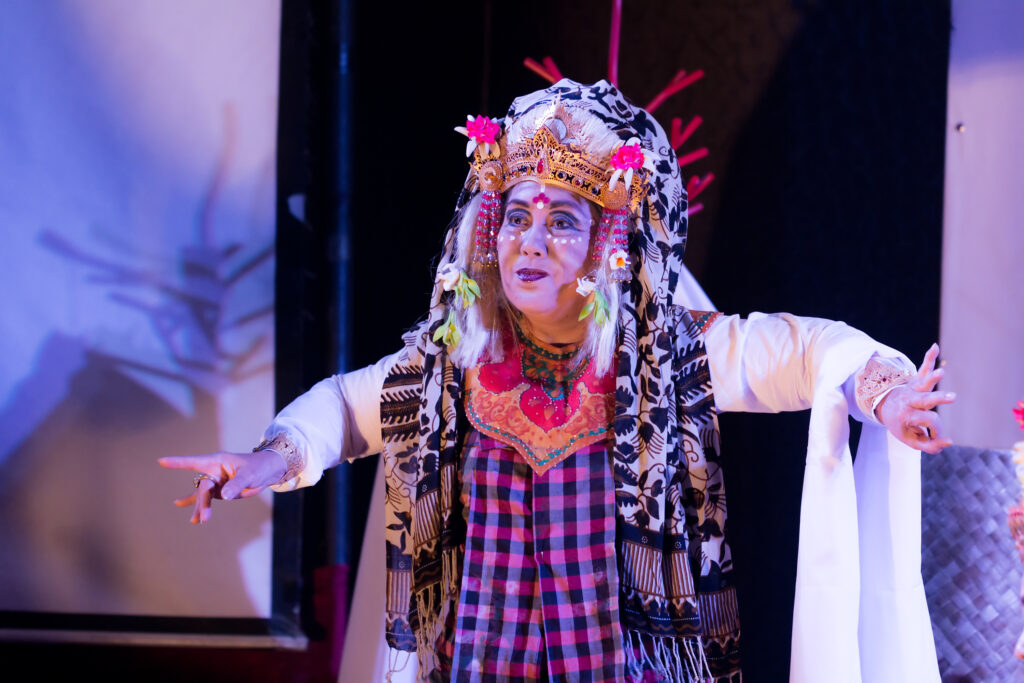Calon Arang, a name that still stirs fear in both children and adults across Bali.
Her story is one of black magic, vengeance, and the thin veil between the living and the dead. Centuries after her legend was first whispered in temple courtyards and village gatherings, her spirit still lingers in ritual, in performance, and in the imagination of the island itself.
Some see her as a powerful witch who defied kings and priests. Others see her as a misunderstood woman, feared for her knowledge and strength.
Either way, Calon Arang’s tale is as much about ancient beliefs and cosmic balance as it is about the timeless battle between light and darkness.
Who Is Calon Arang?

Calon Arang was said to be a powerful widow who lived in the village of Girah, in the Kediri Kingdom, part of modern-day East Java.
Gifted in the dark arts and devoted to the goddess Durga, she was both respected and feared by those around her.
Her beauty had long faded, but her mastery of black magic was unmatched. Locals whispered that she could summon storms, command spirits, and bring death with a single curse.
The widow Calon Arang lived with her beautiful daughter, named Ratna Manggali, whose looks were known throughout the land. Yet, despite her grace, no man dared to ask for her hand; all feared the wrath of her mother.
Consumed by anger and humiliation, Calon Arang turned her powers toward vengeance.
Calon Arang’s Curse

Angry at the ridicule and humiliation she faced, Calon Arang performed forbidden rituals under the full moon in the cemetery, placing a curse on the village of Girah by offering the sacrifice of a young girl to Durga.
Durga descended from the heavens and granted Calon Arang her gift. The village was soon engulfed in floodwater, killing many people, and the subsequent famine and diseases killed many more.
King Airlangga, desperate to save his people, called upon his spiritual teacher, Mpu Baradah, a holy man known for his mastery of white magic. Only he possessed the spiritual strength to confront Calon Arang and restore balance to the world.
Mpu Baradah And Calon Arang’s Demise

Mpu Baradah sent his disciple, Bahula, to marry Ratna Manggali and gain Calon Arang’s trust. The ceremony lasted for seven days, and the celebration pleased Calon Arang. Delighted by her daughter’s wedding, she let down her guard.
But Ratna Manggali, wanting to help her new husband and end the suffering across the land, revealed her mother’s secret: the existence of the sacred scrolls that gave her magical powers.
Bahula invited Mpu Baradah to Girah after he secretly stole the scroll. He studied their contents and prepared to face the witch of Girah. When the time came, he confronted her in the dead of night.
It was then that Calon Arang met Mpu Baradah, the holy man destined to end her reign of terror. Their battle of mantras and spells shook the heavens, Durga’s dark fire clashing with divine light.
In the end, Baradah defeated her and performed a purification ritual to free her spirit. Ratna Manggali wept when she heard of her mother’s demise; despite Calon Arang’s evil, she had always been good to her daughter.
But, even after her defeat, Calon Arang and her story never truly ended.
In Balinese and East Javan tradition, Calon Arang’s spirit lives on through temple dance and ritual, where she is both feared and revered. To this day, her name echoes across Bali and Java as a witch, a priestess, and a symbol of power that defies control.
Calon Arang In Balinese Culture
Although Calon Arang’s story originated in East Java, it’s in Bali that her spirit truly lives on.
Over time, the tale took on new meaning within Balinese Hinduism, where the balance between good and evil is central to daily life.
While her legend has faded in Java, partly due to the rise of Islam and changing local beliefs, in Bali, she remains a living symbol of chaos, transformation, and spiritual power.
Traditional Dance

In Balinese temple ceremonies and cultural performances, Calon Arang appears as Rangda, the Queen of Witches and eternal rival of Barong, the guardian of good.
The Barong and Rangda dance is one of Bali’s most dramatic and sacred performances, retelling the ancient battle between light and darkness. Rangda’s wild hair, long fangs, and bulging eyes capture Calon Arang’s rage and otherworldly strength; yet she isn’t portrayed as purely evil.
Instead, she represents the dark force necessary to maintain cosmic balance, reminding audiences that harmony exists only when both sides are acknowledged.
Where to Experience Calon Arang in Bali

Calon Arang performances are still staged regularly, especially in Ubud, which is known for preserving Bali’s traditional dance and theatre.
You can catch the drama at venues like Ubud Palace, Pura Dalem Ubud, or during temple festivals across the island. These shows often take place at night, using live gamelan orchestras, elaborate costumes, and intense storytelling to bring the legend to life.
Even if you don’t follow every word, the energy, music, and atmosphere are unforgettable.
In Popular Culture

Also dramatised in several movies, notably the 1985 movie Ratu Sakti Calon Arang (Calon Arang the Powerful Queen), and the 2024 horror movie Kutukan Calon Arang (The Curse of Calon Arang).
The 2024 movie is worth watching if you like creepy Indonesian horror movies, but if you’re looking for a history lesson, then be warned, it strays far from the original story.
FAQs
Is Black Magic Real?
Belief in black magic still exists across Bali and Java, and the story of Calon Arang shows why. Villagers who watched her perform forbidden rites said Calon Arang’s magic lingered long after she slept, changing weather, crops and fortunes.
For many locals, these rituals are real, and whether you see them as superstition or spiritual practice, they are an active part of everyday life and ceremony.
Is Calon Arang Real?
There’s no solid historical proof she was a single real person, but the legend reads like it grew from real events and characters.
In some versions, she is an old woman and priestess who met the goddess Durga and practised black magic; in others, she’s more of a literary figure.
Either way, she’s more than a story; she’s a symbol that villages used to explain misfortune, anger and dangerous desire.
Are There Variations In The Story?

Absolutely. As with most old legends, across retellings and performances, the story is depicted differently.
In some versions, Bahula succeeded by being invited into the household and stealing her scrolls; in others, the trick is different.
The way she is finally killed varies, though usually she is killed at the end of a magical battle, in the triumph of good over evil. In one version, an assassination was performed while Calon Arang slept.
What Happened To Mpu Bharadah?
Mpu Baradah is remembered as the holy man who restored balance. After Bahula succeeded in bringing him the scrolls, Baradah confronted Calon Arang, performed purification rites and ended the immediate threat.
In local legend, he either retreated to meditate or was honoured by villagers; in Balinese dance, the cosmic struggle he represents is still depicted as the Barong and Rangda drama, which is as entertaining as it is spiritual.
Where Did the Story of Calon Arang Come From?
Most versions trace the story to East Java around the 11th century, during the reign of King Airlangga.
As the tale travelled to Bali, it evolved within Balinese Hinduism, gaining new meaning through temple ritual and dance. What began as a Javanese story of punishment and witchcraft became a Balinese expression of cosmic balance and spiritual power.
Why Does Calon Arang Still Matter Today?

Her legend continues to shape Balinese culture, reminding people that good and evil are part of the same circle of life.
You’ll see echoes of her story in festivals, theatre, and nightly temple performances, where the line between myth and living tradition feels beautifully blurred.
Final Thoughts On Calon Arang
Calon Arang isn’t just an old story whispered through generations. It’s a reminder of how deeply mythology still breathes in Bali.
The island’s dances, ceremonies and rituals continue to blur the line between the seen and unseen, the living and the spiritual. Experiencing a Calon Arang performance in person, surrounded by the smoke of incense and the pulse of gamelan drums, is as close as you’ll get to witnessing ancient Bali come alive.
It’s haunting, beautiful and a little unsettling, just as it should be.


















